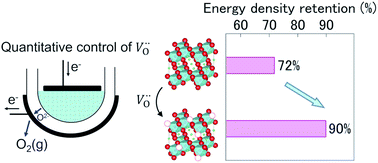Oxygen defect engineering for the Li-rich cathode material Li1.2Ni0.13Co0.13Mn0.54O2−δ†
Abstract
Anion doping is considered a promising approach to improve battery performance by utilizing the functionalities of anion defects. Although the oxygen vacancy is the simplest anion defect in oxide-based cathode materials, the relationship among the oxygen vacancy, crystal structure, electronic structure and electrochemical properties has been poorly understood so far. Here, we controlled the oxygen vacancy concentration in Li1.2Ni0.13Co0.13Mn0.54O2−δ quantitatively by using a solid-electrolyte cell composed of an oxide-ion conductor and evaluated the impact of oxygen vacancies on the electrochemical properties of Li1.2Ni0.13Co0.13Mn0.54O2−δ. It was revealed that the introduction of oxygen vacancies caused reduction expansion of the crystal lattice and selective reduction of Ni and Co. Oxygen-deficient Li1.2Ni0.13Co0.13Mn0.54O1.94 showed better energy density retention (90% after 90 cycles) than the oxygen-stoichiometric sample (72%) by mitigating the voltage decay and the capacity fading upon cycling. We proposed that the enhancement of the reversible transition metal migration due to the reduction expansion of the crystal lattice mitigated the voltage decay, and selective reduction of Ni and Co enhanced the redox capability of Ni and Co in the subsequent charge/discharge. The findings of this work proved the effectiveness of oxygen defect engineering for oxide-based battery materials.

- This article is part of the themed collection: Energy Frontiers: Electrochemistry and Electrochemical Engineering


 Please wait while we load your content...
Please wait while we load your content...